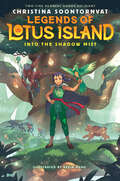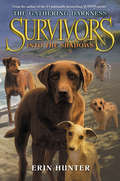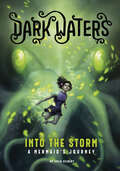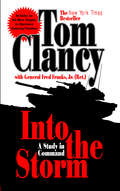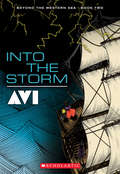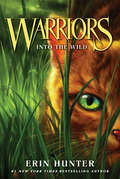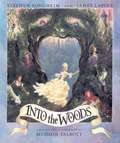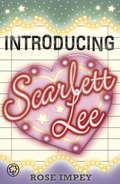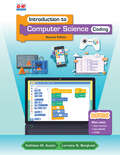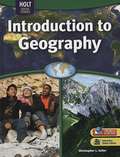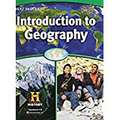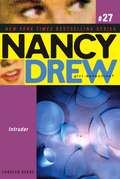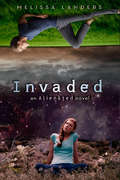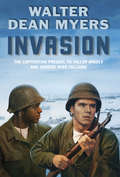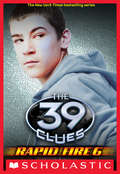- Table View
- List View
Into the Shadow Mist (Legends of Lotus Island)
by Christina SoontornvatFrom two-time Newbery honor recipient Christina Soontornvat comes a compelling new young middle grade fantasy series for readers who love stories about animals, magic, and kids like them embracing their power to change the world.Plum and her friends are traveling to the misty Bokati Island. There they will study with the mysterious Guardian Master Em, who is the keeper of the ancient forest there. The field trip comes just in time for Plum, who still can’t figure out why she’s so different from the other Novices on Lotus Island.At first, Plum doesn’t know what to make of this quiet and sometimes gloomy place. But it doesn't take long to discover that Bokati is brimming with an incredible array of fascinating animals and plants.When an unseen force begins to destroy the trees, putting the entire ecosystem at risk, Plum and her classmates must spring into action. Plum is determined to help, even though she's hiding secrets about her own Guardian powers from even her closest friends.
Into the Shadows (Survivors: The Gathering Darkness #3)
by Erin Hunter Julia Green Laszlo KubinyiDarkness threatens the Wild Pack in this epic third book in the second Survivors series! From Erin Hunter, #1 nationally bestselling author of Warriors, Survivors is full of “wild and wonderful adventure” (Kirkus Reviews, starred review) that will thrill fans of Spirit Animals and Wings of Fire.Storm is determined to protect her Pack from any threat—but how can she protect it from her own Packmates? Some dog is sabotaging the Pack from within, and suspicion and distrust are tearing the dogs apart. If they don’t uncover the traitor soon, there will be nothing left for Storm to protect...
Into the Storm (Left Behind: The Kids #11)
by Tim Lahaye Jerry B. Jenkins Chris FabryFilled with grief over the loss of their friend, the Young Trib Force hears scary details of the future. As Judd hides, the others must help him find secret documents to combat the Global Community. Lionel faces a life changing decision. Vicki must deliver the most convincing edition of the UNDERGROUND yet. Follow Judd, Vicki. Lionel, Ryan, and the growing Young Trib Force as they encounter new dangers and a world crumbling beneath them
Into the Storm: A Mermaid's Journey (Dark Waters Ser.)
by Julie GilbertWhen a hurricane threatens to harm the underwater homes of the merpeople, it is up to India Finch, a part-human/part-mermaid teenager, to warn her ocean friends. The mer decide to seek calmer waters, and as they travel, they are attacked by a giant squid, with India at the center of harm's way. Gravely injured, India depends on the merfolks' willingness to risk their own safety to get her ashore where her injuries can be treated. Will the prejudice many mer hold against humans leave India at the end of her journey? Reader tools include a glossary and discussion questions in this Hi-Lo novel for reluctant and struggling readers.
Into the Storm: A Study in Command
by Tom Clancy Frederick M. FranksIn his brilliant, bestselling novels, Tom Clancy has explored the most timely military and security issues of our generation. Now he takes readers deep into the operational art of war with this insightful look at one of the greatest American military triumphs since World War II: the Gulf War.
Into the Storm: Beyond the Western Sea Book 2 (Beyond the Western Sea #2)
by AviAvi's suspenseful seafaring adventure ESCAPE FROM HOME continues in INTO THE STORM.Fifteen-year-old Maura and twelve-year-old Patrick O'Connell are finally free from the impoverished conditions of their small Irish village. Though they've made it onto the ship to America, there's still a treacherous journey ahead of them.In the storage hold, ten-year-old Laurence Kirkle struggles to survive and stay hidden as the ship's crew searches for stowaways to throw overboard. All three children are in search of a better world and a new home. But will they find what they're looking for in America?Once again, Avi skillfully creates an edge-of-your-seat adventure brimming with action and heart.
Into the Trap
by Craig MoodieAn action-packed adventure about thieves, fishing, and two boys who lay a trap that will save the day.Eddie's family has been trapping lobsters for generations. but lately someone has been stealing their catch. When Eddie happens across the thieves' trap, he knows it's up to him to bring in the culprits. With the unlikely help of a boy who has run away from sailing camp, Eddie embarks on an adventure that puts his very life at risk.
Into the Wild (Warriors: The Prophecies Begin #1)
by Erin HunterFire alone can save our Clan... For generations, four Clans of wild cats have shared the forest according to the laws laid down by the powerful ancestors. But the warrior code is threatened, and the ThunderClan cats are in grave danger. The sinister ShadowClan grows stronger every day. Noble warriors are dying -- and some deaths are more mysterious than others. In the midst of this turmoil appears an ordinary housecat named Rusty . . . Who may yet turn out to be the bravest warrior of them all.
Into the Woods: Easy Piano Selections From The Disney Movie
by Stephen Sondheim James LapineFinally Back in Print in Over a Decade, the Lavishly Illustrated Book of Into the Woods, One of the Most-Performed Musicals, by Pulitzer Prize- and Tony Award-winning Stephen Sondheim and James LapineBased on the Grimm Brothers&’ most popular folktales, Into the Woods is a reimagining of what can happen when beloved fairytale characters are thrown together in increasingly dramatic and humorous ways. The Pulitzer Prize- and Tony Award-winning team of Stephen Sondheim and James Lapine bring their cherished musical off the stage and onto the page with the help of Hudson Talbott&’s enchanting illustrations.Published for Stephen Sondheim&’s ninetieth birthday, join Cinderella, Jack (of beanstalk-climbing fame), Little Red Riding Hood, the Baker and his Wife, and more on their quest to find &“happily ever after.&” Along the way they meet Rapunzel, the Big Bad Wolf, terrifying giants, lusty princes, and their own destinies. But after their journeys are done, the real question remains: what comes after &“happily ever after&” and will the prices paid for it be worth it in the end?
Intro to Business
by Robert A. RistauThe 21ST CENTURY BUSINESS SERIES is an innovative instructional program providing instructors with the greatest flexibility to deliver business content using a modular format. Instructors can create their own business courses by combining several Learner Guides in the Series to form one-semester or two-semester courses. The individual Learner Guides can also be used as enhancements to more traditional business courses or to tailor new courses to meet emerging needs. The design and content of each Learner Guide in the 21ST CENTURY BUSINESS SERIES is engaging yet easy for students to use. The content focuses on providing opportunities for applying 21st skills while enabling innovative learning methods that integrate the use of supportive technology and creative problem solving approaches in today's business world. The Introduction to Business Learner Guide covers today's most relevant business topics such as how business has been affected by the global economic crisis and recovery as well as global environmental issues. The roles of marketing and human resources management are also incorporated into this Learner Guide.
Introducing Literature
by MacmillanA book that collates poems, songs, plays, stories among other literary works in the aim of introducing literature in an exciting and interesting way to the students.
Introducing Scarlett Lee
by Rose ImpeyScarlett is a drama queen in every sense. Larger than life, she lives to act and sometimes has trouble remembering when the drama lesson ends and real life resumes. When her father seems to 'disappear', Scarlett suddenly finds herself in a real-life drama of her own. Will she be able to uncover the mystery and discover just who she can trust and who is really putting on an act?
Introduction to Chemistry 2: How Can I Make New Stuff from Old Stuff? (IQWST)
by Joseph Krajcik Brian ReiserNIMAC-sourced textbook
Introduction to Chemistry interactive SCIENCE
by Michael J. Padilla Don Buckley Zipporah MillerMiddle Grade Science Textbook
Introduction to Computer Science Coding
by Kathleen M. Austin Lorraine N. BergkvistIntroduction to Computer Science: Coding is a one-of-a-kind text that introduces younger students to the exciting world of computer coding. Built for exploring computer science courses, this text shows students how easy it is to learn coding and is a great tool for encouraging students to pursue additional courses in computer science and IT. Designed for the classroom, this text provides a foundation in the concepts of programming using easy-to-learn, free software: Scratch, MIT App Inventor, OpenSCAD, and HTML.
Introduction to Psychology
by Mcdougal LittellSome of the topics covered in this book include: the world of psychology, research in psychology, psychology & the brain, sensation, perception, consciousness, learning, memory and intelligence among others.
Introduction to Technology
by Alan J. Pierce Dennis KarwatkaStudents will discover technology through project-based pedagogy with Glencoe's Introduction to Technology! Teachers and students are offered content that is driven by projects to facilitate hands-on understanding and learning, while academics are integrated in unit-based projects and chapter-based Technology Labs. Students are invited to play and "crack the code" with the Technology Time Machine game while learning the key content of the technology literacy standards. Prepare students for TSA competitive events with prep activities embedded throughout the content and end-of-chapter assessments. Rigorous academic content is fully supported, especially in math, geometry, and science, with STEM activities throughout. Point-of-use academic correlations are included to ease possible academic credit application. Teachers can meet Perkins mandates for academic excellence with extra activities in the Student Edition and in the Project Applications Workbook. Careers profiles, Tech Stars, Imagine This! and Eco Tech features enhance the content with relevant information and challenging activities.
Introductory Physical Science
by Uri Haber-Schaim Peter Gendel H. Graden KirkseyNIMAC-sourced textbook
Intruder
by Carolyn KeeneNancy must catch a powler before he ruins the day!The library's Jane Austen Tea Party benefit is put in jeopardy when someone starts sabotaging the Bed and Breakfast hosting the event. Nancy has been called on to figure out how the prowler is getting into the house and why.
Intuitive Parenting: How to tune in to your innate wisdom
by Jennifer DayReconnect with your parenting intuition and the innate wisdom it provides with simple, practical steps. Reduce stress and overwhelm, and improve your confidence and relationships.Parents today are inundated with information and expert advice, often contradictory and invariably overwhelming. This results in anxiety, insecurity and stressed parenting that inevitably drives wedges between parents and children instead of the much-needed connection. This book offers swift, practical and to-the-point information to help you reconnect with your innate wisdom, giving you the confidence to trust your own parenting intuition. · Learn what gets in the way of connecting to your intuition and how to eliminate it· Discover the key - and underused - ingredient to your own parenting blueprint· Learn the three levels of influence you have on your child and how (and why) to align them· Discover the one simple tool to managing your stress - so easy your child can do it too· Learn how to give unspoken support and how to practice true listening The practical everyday applications this book offers will reduce your anxiety and help you to connect and be fully present with your child, improving relationships for you both.
Invaded (Alienated #2)
by Melissa LandersCara always knew life on planet L'eihr would be an adjustment. With Aelyx, her L'eihr boyfriend, back on Earth, working to mend the broken alliance between their two planets, Cara is left to fend for herself at a new school, surrounded by hostile alien clones. Even the weird dorm pet hates her. Things look up when Cara is appointed as human representative to a panel preparing for a human colony on L'eihr. A society melding their two cultures is a place where Cara and Aelyx could one day make a life together. But with L'eihr leaders balking at granting even the most basic freedoms, Cara begins to wonder if she could ever be happy on this planet, even with Aelyx by her side. Meanwhile, on Earth, Aelyx, finds himself thrown into a full-scale PR campaign to improve human-L'eihr relations. Humans don't know that their very survival depends on this alliance: only Aelyx's people have the technology to fix the deadly contamination in the global water supply that human governments are hiding. Yet despite their upper hand, the leaders of his world suddenly seem desperate to get humans on their side, and hardly bat an eye at extremists' multiple attempts on Aelyx's life. The Way clearly needs humans' help? But with what? And what will they ask for in return?
Invasion
by Walter Dean MyersWalter Dean Myers brilliantly renders the realities of World War II.Josiah Wedgewood and Marcus Perry are on their way to an uncertain future. Their whole lives are ahead of them, yet at the same time, death's whisper is everywhere. One white, one black, these young men have nothing in common and everything in common as they approach an experience that will change them forever. It's May 1944. World War II is ramping up, and so are these young recruits, ready and eager. In small towns and big cities all over the globe, people are filled with fear. When Josiah and Marcus come together in what will be the greatest test of their lives, they learn hard lessons about race, friendship, and what it really means to fight. Set on the front lines of the Normandy invasion, this novel, rendered with heart-in-the-throat precision, is a cinematic masterpiece. Here we see the bold terror of war, and also the nuanced havoc that affects a young person's psyche while living in a barrack, not knowing if today he will end up dead or alive.
Invasion (The 39 Clues: Rapid Fire #6)
by Clifford RileyThe sixth of seven brand new 39 Clues stories leading up to one explosive reveal. Dan Cahill loves hanging out with his new friend Atticus Rosenbloom a child prodigy whose genius IQ doesn't stop him from playing video games or practicing ninja moves. It's a relief to get to pretend to be a normal kid for once and not worry about finding Clues or looking out for Vespers. But when Atticus's house is attacked by strange intruders Dan has to rely on his Cahill training to keep them out. Are they normal burglars? Or does Atticus's family have a secret of its own?
